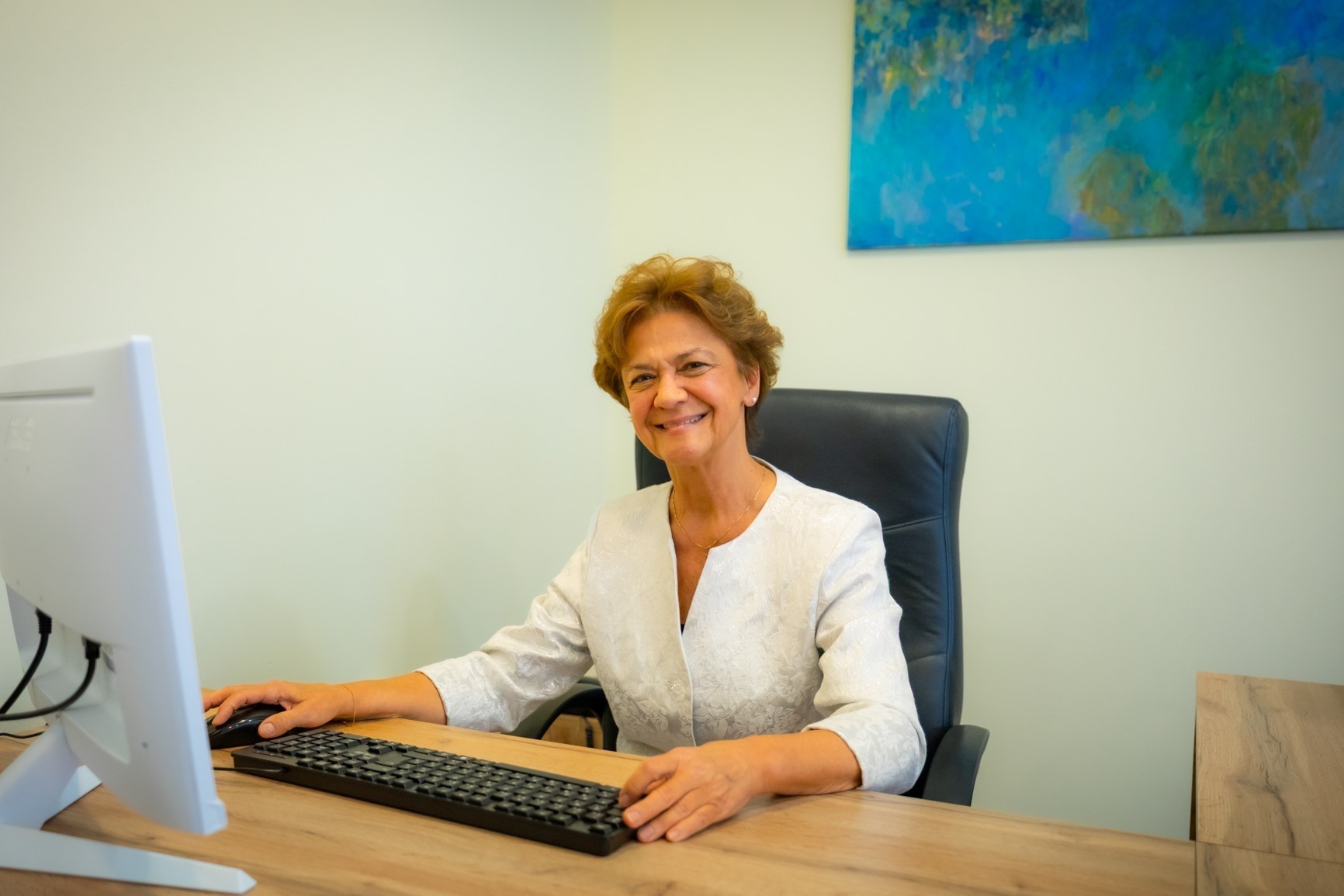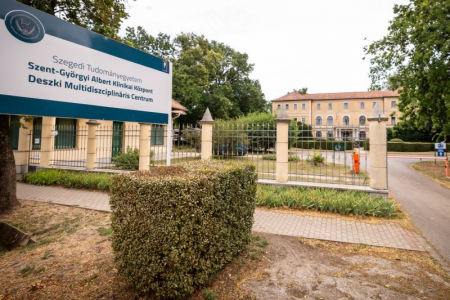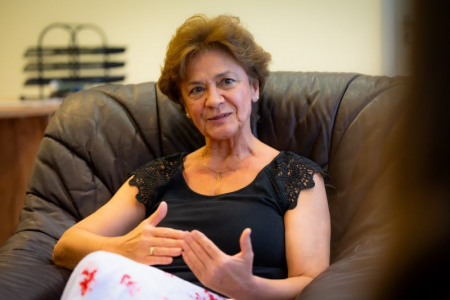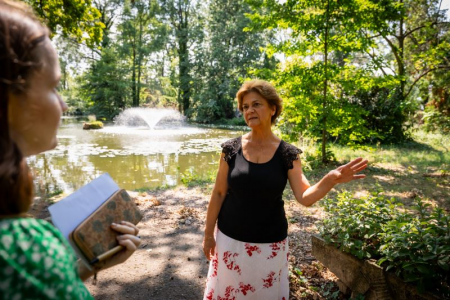University of Szeged
Albert Szent-Györgyi Medical School
Foreign Students' Secretariat
Your Education. Our Mission.

"You can't just sit on a gold mine" – interview with Dr. Judit Moldvay, head of the Department of Pulmonology at the University of Szeged
Dr. Judit Moldvay is a doctor of the Hungarian Academy of Sciences, head physician at the National Korányi Pulmonology Institute, lecturer at Semmelweis University, and, since 2024, head of the Department of Pulmonary at the University of Szeged.
Dr. Judit Moldvay is a doctor of the Hungarian Academy of Sciences, head physician at the National Korányi Pulmonology Institute, lecturer at Semmelweis University, and, since 2024, head of the Department of Pulmonary at the University of Szeged. She is a teacher, researcher, and takes part in everyday patient care. This year, she has been the co-author of two Nature publications: the article in Nature Neuroscience reported on a Hungarian study, while the Nature Cancer publication was the result of international collaboration.
This year, your name has emerged among the authors of two Nature publications. Could you tell us about these studies?
Many years of work have now culminated in these articles. During the pandemic, the National Korányi Pulmonology Institute played a leading role in the care of COVID patients, which enabled us to join the domestic brain research led by Professor Ádám Dénes. The essence of the study was to investigate the neurological disorders observed in COVID-19, for which brain tissue samples from patients who died at Korányi and documentation of the course of their disease provided the clinical background. mRNA-based studies have confirmed that SARS-CoV-2-induced inflammation can lead to microglial dysfunction and mitochondrial damage in the brain, which may contribute to the development of various neurological disorders associated with COVID-19.
The Nature Cancer article is part of a series of studies that have been conducted in collaboration with Charles Swanton and researchers at the Francis Crick Institute in London for nearly 10 years. It is a great honor to be involved in work of this caliber. This research focuses on the predictability of lung cancer recurrence. Some patients who undergo surgery in the early stages are cured with the surgical removal of the tumor, but in others, the disease unfortunately recurs after 2-3 years. Currently, we do not have a marker that can be used in clinical practice to clearly predict who will experience a recurrence of the tumor and who will be cured with surgery. Charlie and his colleagues have developed a scoring system based on detailed molecular genetic analysis of surgically removed lung cancer tissue samples, which predicts the patient's prognosis more accurately than the currently used TNM staging system. The scoring system was named ORACLE, which stands for "Outcome Risk Associated Clonal Lung Expression." The research was aided by tissue samples from lung adenocarcinoma surgically removed from hundreds of Hungarian patients.
Is it good for patients to know what to expect in advance? If patients receive a serious prognosis and lose hope, will this have a negative impact on the outcome? How would predictability help?
It is important to emphasize that this method cannot be applied in clinical practice tomorrow, but it does indicate a direction for research and development. One consequence of the predictability of recurrence may be that we will monitor patients at higher risk much more closely, follow-up protocols will become stricter, and we will check on them more frequently. They will receive postoperative oncotherapy even at a very early stage, which is currently contraindicated, even though the disease recurs in 5-10% of cases within 5 years. In contrast, patients whose tumors show more favorable biological behavior can avoid post-surgical chemotherapy treatments, which are not harmless. We hope to be able to truly personalize post-surgical care for patients, but to do so, we need to know much more about each patient's tumor.
International research groups, including big names in the field such as Charles Swanton, seek us out because we can provide them with reliable and accurate clinical data and high-quality patient samples. Ten years ago, as part of the National Brain Research Program, we succeeded in establishing an archive of frozen tumor and blood samples with the thoracic surgeons and pathologists of the National Korányi Pulmonology Institute and neurosurgeons in order to study the primary tumor and brain metastases of the same patient and gain a better understanding of the mechanism of metastasis. This archive has since served as a treasure trove for numerous other research projects, and I plan to implement something similar in Szeged.

In addition to research, you are also involved in everyday patient care. Do you think these two activities have an impact on each other? Can you be a better researcher by being involved in patient care, and vice versa?
Yes, they definitely influence each other. I started my career as a pathologist at SOTE, but I always wanted to be a clinician, and that's what I have become: a pulmonologist and clinical oncologist. At the beginning of my career, I spent two years in Paris as a fellow of the ARC (Association pour la Recherche sur le Cancer), where, in the early 1990s, I learned molecular genetic testing methods (e.g., PCR, in situ hybridization, etc.) that are now routinely used in clinical practice. After two years of research in Paris, I became a clinician in the National Korányi Pulmonology Institute, and I recently calculated that I have performed nearly 10,000 bronchoscopic examinations over the years. I wrote my PhD thesis on lung cancer research as a clinician, and 20 years later, the topic of my postdoctoral thesis was also "The investigation of prognostic and predictive factors in lung cancer."
In my experience, pathology is commonly equated with autopsy. Would you comment on this?
It is very important to dispel such stereotypes. No doubt, when I was a young pathologist, a significant part of my work consisted of autopsies. This was not useless, because during an autopsy we focus not only on one organ, but on the whole body: we have to recognize all of the patient's diseases that are visible to the naked eye. Since I had always intended to become a clinician, I had a clinical mindset even as a pathologist, so at that time I began my practice by reviewing the patient's clinical documentation, ECG, and X-ray findings with my students, and imagining what abnormalities we might see during the autopsy. Today, the number of autopsies has decreased significantly and has been replaced by histological, immunohistochemical, and molecular genetic testing. When I was a pathologist in the late 1980s, pathology was very distant from patients. The kind of closeness that exists today, for example, in a cytology clinic, was unimaginable: we meet the patients, ask them questions, take a sample of the lesion, and then give a pathological diagnosis. To be honest, if this kind of doctor-patient relationship had existed at that time, I'm not sure I would have switched to clinical practice. However, working with patients and helping them is important to me.

You work with cancer patients, which can be very draining emotionally. What motivates you, what gives you strength in your daily work?
It's not easy, because I'm confronted with suffering and death every day, but we can't die with every patient. We have to help, support, and encourage the next patient, be there for them and their family. On the one hand, research helps me: even with a sad diagnosis, I can see, for example, that we can include this case in an ongoing research project. In addition, a secure family background also gives me tremendous strength.
What is your approach to teaching? What do you want to convey?
We need to spark enthusiasm in young people and try to maintain it; Albert Szent-Györgyi also preached this. Motivation is the key, which I also try to provoke at home with my 19- and 20-year-old children. The important thing is that they want to set their own goals and achieve them. The other important thing I consider to be my task here in Szeged is the positioning of pulmonology. During COVID, it became clear that everyone loves to breathe, yet this field is not sufficiently known and recognized. COPD, chronic obstructive pulmonary disease, is a public health problem that affects 4-5% of the population, and lung cancer is the leading cause of cancer deaths worldwide and in Hungary. This is not only a major task for pulmonology, but public education is also important in this regard, as smoking is responsible for 85-90% of COPD and lung cancer cases.
I also like to show my students how interdisciplinary pulmonology is. In the last pulmonology lecture for fourth-year medical students, I show a series of slides, each of which deals with a different department of the Medical School and its connection to pulmonology. Almost all of the case histories briefly presented are from my own patients, as I have been a clinician for more than 30 years. At first, I thought it would be difficult to find a pulmonology case for each department, but in the end it proved surprisingly easy: each slide had one or two specific cases with endoscopic photos, X-rays, or CT images of my own patients.

What opportunities are there in Deszk for PhD students, young researchers, or residents?
One of my big dreams is that we can establish the same kind of international collaborations in Szeged that I have been able to achieve in Budapest. The first step has already been taken: we recently acquired a deep freezer, so we can start collecting patients' blood samples according to specific criteria in order to engage in promising collaborations.
Are there practical and research opportunities?
I would consider it ideal if young people were actively involved in research in addition to patient care. Pulmonology is extremely diverse and involves a lot of manual work, so in addition to blood samples, bronchoscopic tissue samples and fluid collected through chest drainage can also serve as research material. Whether someone starts working in Deszk as a resident or a PhD student, sooner or later they will be able to take a peek at the other side. Although there is currently no research laboratory here, I can refer young people to the laboratory managers I work with.
In your opinion, what is the future of cancer treatments?
In 2004, there was a huge breakthrough in lung cancer therapy. That was the year when two independent research groups confirmed that if a certain genetic mutation is detected in the tumor, patients suffering from the disease can be treated with one pill a day, and the results are often spectacular. This was the first of molecular targeted therapies, EGFR inhibitor treatment. Then, about 10 years ago, immunotherapy came along, which is also a fantastic advance. With immunotherapy, we do not attack the tumor directly, but rather tell the body's immune cells, ’Wake up, there's an intruder here, destroy it!’ The immune system is basically blocked in all of us, because if it weren't, we would suffer from autoimmune diseases. So there is a brake that is vital, but in the fight against tumors, this brake must be removed, and that is what immunotherapy does. It is important to know that in about 15-20% of patients receiving this treatment, we can achieve very good, long-term results. However, while we already know who will respond well to molecular targeted therapy, we do not yet have a truly good predictive marker for immunotherapy. This is also an important issue in terms of cost-effectiveness, as these drugs are expensive. We currently have a research program with Zoltán Szállási in which we are investigating predictive markers for immunotherapy. In addition to the two therapeutic modalities mentioned above, another promising approach is the mRNA-based cancer vaccine, in which we use the body to produce proteins specific to the tumor. It was a great honor for me to select the first lung cancer patient in the world to receive the mRNA-based cancer vaccine developed based on Katalin Karikó's method in 2022. With this vaccine, we did not produce proteins specific to the patient's tumor, but rather proteins that are generally characteristic of lung cancer, and combined it with immunotherapy during the clinical trial, but in the future we will certainly use the mRNA vaccine to present proteins selected based on the patient's own tumor to the immune system, which we will then stimulate with what is now considered traditional immunotherapy.

You have also worked in Paris. Did you ever consider staying abroad?
As a researcher and pathologist, I have often beeb tempted to work abroad, but nowadays I think there are great opportunities here at home. I always advise young people that if they have the opportunity, they should go abroad, look around, but then come home and bring their knowledge and experience with them. As a researcher, I would go anywhere in the world, but as a practicing physician, I think I could only treat Hungarian patients.





